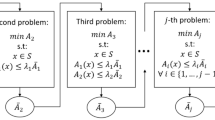Abstract
LKAB’s Kiruna Mine, located in northern Sweden, produces about 24 million tons of iron ore yearly using an underground mining method known as sublevel caving. To aid in its ore mining and processing system, Kiruna has adopted the use of several types of multi-period production scheduling models that have some distinguishing characteristics, for example: (i) specific rules governing the way in which the ore is extracted from the mine; (ii) lack of an inventory holding policy; and (iii) decisions that are not explicitly cost-based. In this chapter, we review two models in use at Kiruna and three techniques we have employed to expedite solution time, support the efficacy of these techniques with numerical results, and provide a corresponding discussion.
Access this chapter
Tax calculation will be finalised at checkout
Purchases are for personal use only
Preview
Unable to display preview. Download preview PDF.
Similar content being viewed by others
References
Almgren, T. (1994). An Approach to Long Range Production and Development Planning with Application to the Kiruna Mine, Sweden, Luleå University of Technology, Doctoral Thesis number 1994:143D.
AMPL. (2001). Version 10.6.16, Bell Laboratories.
Barbara, R.W. and R.V. Ramani. (1986). “Generalized Multiperiod MIP Model for Production Scheduling and Processing Facilities Selection and Location,” Mining Engineering 38(2): 107–114.
Carlyle, M. and B.C. Eaves. (2001). “Underground Planning at Stillwater Mining Company,” Interfaces 31(4): 50–60.
CPLEX. (2001). Version 7.0, ILOG Corporation.
CPLEX. (2004). Version 9.0, ILOG Corporation.
Dagdelen, K., M. Kuchta, and E. Topal. (2002). “Linear Programming Model Applied to Scheduling of Iron Ore Production at the Kiruna Mine, Kiruna, Sweden,” Transactions of the Society for Mining, Metallurgy, and Exploration, 312: 194–198.
Fourer, R., D. Gay, and B. W. Kernighan. (2003). AMPL: A Modeling Language for Mathematical Programming, Thompson Learning, Pacific Grove, CA.
Hochbaum, D. S. and A. Chen. (2000). “Performance Analysis and Best Implementations of Old and New Algorithms for the Open-Pit Mining Problem,” Operations Research 48(6): 894–914.
Jawed, M. (1993). “Optimal Production Planning in Underground Coal Mines through Goal Programming—A Case Study from an Indian Mine,” in Proceedings, 24 th International Symposium on the Application of Computers in the Mineral Industry, Montreal, Quebec, Canada: 43–50.
Kuchta, M. (2002). “A Database Application for Long Term Production Scheduling at LKAB’s Kiruna Mine,” in Proceedings, 30 th International Symposium on the Application of Computers in the Mineral Industry, Phoenix, AZ: 797–804.
Kuchta, M., A. Newman, and E. Topal. (2004). “Implementing a Production Schedule at LKAB’s Kiruna Mine,” Interfaces 34(2): 124–134.
Lerchs, H., I.F. Grossmann. (1965). “Optimum Design of Open Pit Mines,” Transactions, Canadian Mining Institute 68: 17–24.
Martin, R. Kipp. (1999). Large Scale Linear and Integer Optimization, Kluwer Academic Publishers, Boston MA.
Martinez, M., A. Newman, and M. Kuchta. (2005) “Using Decomposition to Optimize Long-and Shortterm Production Planning at an Underground Mine,” Working Paper, Division of Economics and Business and Mining Engineering Department, Colorado School of Mines, Golden, CO, November.
Newman, A., and M. Kuchta. (2005). “Using Aggregation to Optimize Long-term Production Planning at an Underground Mine,” European Journal of Operational Research, to appear.
Newman, A., M. Kuchta, and M. Martinez. (2005). “Long-and Short-term Production Scheduling at LKAB’s Kiruna Mine,” Handbook of Operations Research in Natural Resources, A. Weintraub and R. Epstein, eds., Springer, to appear.
Newman, A. and C. Yano. (2000). “Scheduling Direct and Indirect Trains and Containers in an Intermodal Setting,” Transportation Science 43(3): 256–270.
Sarin, S. and J. West-Hansen. (2005). “The Long-term Mine Production Scheduling Problem,” HE Transactions, 37(2): 109–121.
Smith, M.L. (1998). “Optimizing Short-term Production Schedules in Surface Mining: Integrating Mine Modeling Software with AMPL/CPLEX,” International Journal of Surface Mining 12(4): 149–155.
Smith, M.L., Sheppard, I. and G. Karunatillake. (2003). “Using MIP for Strategic Life-of-mine Planning of the Lead/zinc Stream at Mount Isa Mines,” in Proceedings, 31 st International Symposium on the Application of Computers in the Mineral Industry, Capetown, South Africa: 465–474.
Tang, X., G. Xiong, and X. Li. (1993). “An Integrated Approach to Underground Gold Mine Planning and Scheduling Optimization,” in Proceedings, 24 th International Symposium on the Application of Computers in the Mineral Industry, Montreal, Quebec, Canada: 148–154.
Topal, E. (1998). Long and Short Term Production Scheduling of the Kiruna Iron Ore Mine, Kiruna, Sweden, Master of Science Thesis, Colorado School of Mines, Golden, CO.
Trout, L.P. (1995). “Underground Mine Production Scheduling Using Mixed Integer Programming,” in Proceedings, 25 th International Symposium on the Application of Computers in the Mineral Industry, Brisbane, Australia: 395–400.
Underwood, R. and B. Tolwinski. (1998). “A Mathematical Programming Viewpoint for Solving the Ultimate Pit Problem,” European Journal of Operational Research 107(1): 96–107.
Williams, J., L. Smith, and M. Wells. (1972). “Planning of Underground Copper Mining,” in Proceedings, 10 th International Symposium on the Application of Computers in the Mineral Industry, Johannesburg, South Africa: 251–254.
Winkler, B.M. (1996). “Using MILP to Optimize Period Fix Costs in Complex Mine Sequencing and Scheduling Problems,” in Proceedings, 26 th International Symposium on the Application of Computers in the Mineral Industry, Pennsylvania State University, University Park, PA: 441–446.
Winkler, B.M. (1998). “Mine Production Scheduling Using Linear Programming and Virtual Reality,” in Proceedings, 27 th International Symposium on the Application of Computers in the Mineral Industry, Royal School of Mines, London, United Kingdom: 663–673.
Author information
Authors and Affiliations
Editor information
Editors and Affiliations
Rights and permissions
Copyright information
© 2006 Springer Science+Business Media, Inc.
About this chapter
Cite this chapter
Newman, A.M., Martinez, M., Kuchta, M. (2006). A Review of Long- and Short-Term Production Scheduling at Lkab’s Kiruna Mine. In: Herrmann, J.W. (eds) Handbook of Production Scheduling. International Series in Operations Research & Management Science, vol 89. Springer, Boston, MA. https://doi.org/10.1007/0-387-33117-4_11
Download citation
DOI: https://doi.org/10.1007/0-387-33117-4_11
Publisher Name: Springer, Boston, MA
Print ISBN: 978-0-387-33115-7
Online ISBN: 978-0-387-33117-1
eBook Packages: Business and EconomicsBusiness and Management (R0)




